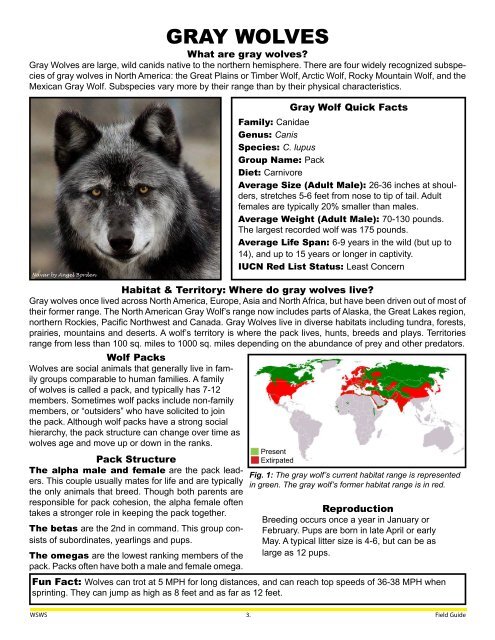Wild Spirit Wolf Sanctuary Educational Field Guide
Wild Spirit Wolf Sanctuary’s Student Field Guide provides readers with in depth details on the species of wild canids our Sanctuary houses, including their physical characteristics, behaviors, similarities and differences, territory, endangered species status, and the important functions these animals play in their native ecosystems. We hope you have a howling good time reading our Field Guide!
Wild Spirit Wolf Sanctuary’s Student Field Guide provides readers with in depth details on the species of wild canids our Sanctuary houses, including their physical characteristics, behaviors, similarities and differences, territory, endangered species status, and the important functions these animals play in their native ecosystems. We hope you have a howling good time reading our Field Guide!
Create successful ePaper yourself
Turn your PDF publications into a flip-book with our unique Google optimized e-Paper software.
GRAY WOLVES<br />
What are gray wolves?<br />
Gray Wolves are large, wild canids native to the northern hemisphere. There are four widely recognized subspecies<br />
of gray wolves in North America: the Great Plains or Timber <strong>Wolf</strong>, Arctic <strong>Wolf</strong>, Rocky Mountain <strong>Wolf</strong>, and the<br />
Mexican Gray <strong>Wolf</strong>. Subspecies vary more by their range than by their physical characteristics.<br />
Navar by Angel Borden<br />
<strong>Wolf</strong> Packs<br />
Wolves are social animals that generally live in family<br />
groups comparable to human families. A family<br />
of wolves is called a pack, and typically has 7-12<br />
members. Sometimes wolf packs include non-family<br />
members, or “outsiders” who have solicited to join<br />
the pack. Although wolf packs have a strong social<br />
hierarchy, the pack structure can change over time as<br />
wolves age and move up or down in the ranks.<br />
Pack Structure<br />
The alpha male and female are the pack leaders.<br />
This couple usually mates for life and are typically<br />
the only animals that breed. Though both parents are<br />
responsible for pack cohesion, the alpha female often<br />
takes a stronger role in keeping the pack together.<br />
The betas are the 2nd in command. This group consists<br />
of subordinates, yearlings and pups.<br />
The omegas are the lowest ranking members of the<br />
pack. Packs often have both a male and female omega.<br />
Gray <strong>Wolf</strong> Quick Facts<br />
Family: Canidae<br />
Genus: Canis<br />
Species: C. lupus<br />
Group Name: Pack<br />
Diet: Carnivore<br />
Average Size (Adult Male): 26-36 inches at shoulders,<br />
stretches 5-6 feet from nose to tip of tail. Adult<br />
females are typically 20% smaller than males.<br />
Average Weight (Adult Male): 70-130 pounds.<br />
The largest recorded wolf was 175 pounds.<br />
Average Life Span: 6-9 years in the wild (but up to<br />
14), and up to 15 years or longer in captivity.<br />
IUCN Red List Status: Least Concern<br />
Habitat & Territory: Where do gray wolves live?<br />
Gray wolves once lived across North America, Europe, Asia and North Africa, but have been driven out of most of<br />
their former range. The North American Gray <strong>Wolf</strong>’s range now includes parts of Alaska, the Great Lakes region,<br />
northern Rockies, Pacific Northwest and Canada. Gray Wolves live in diverse habitats including tundra, forests,<br />
prairies, mountains and deserts. A wolf’s territory is where the pack lives, hunts, breeds and plays. Territories<br />
range from less than 100 sq. miles to 1000 sq. miles depending on the abundance of prey and other predators.<br />
Present<br />
Extirpated<br />
Fig. 1: The gray wolf’s current habitat range is represented<br />
in green. The gray wolf’s former habitat range is in red.<br />
Reproduction<br />
Breeding occurs once a year in January or<br />
February. Pups are born in late April or early<br />
May. A typical litter size is 4-6, but can be as<br />
large as 12 pups.<br />
Fun Fact: Wolves can trot at 5 MPH for long distances, and can reach top speeds of 36-38 MPH when<br />
sprinting. They can jump as high as 8 feet and as far as 12 feet.<br />
WSWS 3. <strong>Field</strong> <strong>Guide</strong>


